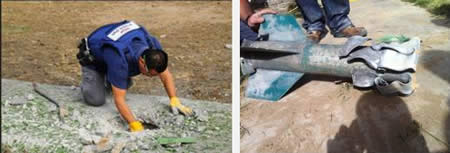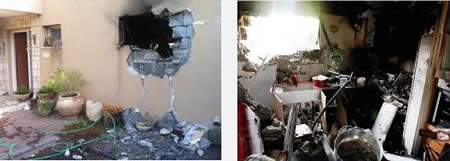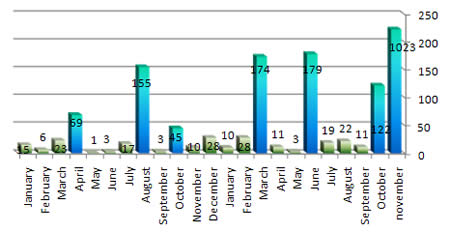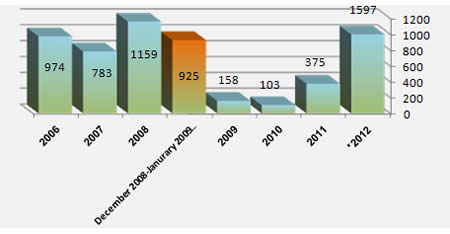Overview
1. During the first half of November 18, the fifth day of Operation Pillar of Defense, the Palestinian terrorist organizations continued launching rockets into Israeli territory (an estimated 70 rocket hits were identified, including one intercepted by the Iron Dome aerial defense system over Tel Aviv; another was intercepted over Tel Aviv in the evening). The IDF continued attacking terrorist targets in the Gaza Strip.
2. The situation on the ground so far:
1) Israeli Air Force aircraft have attacked more than 800 terrorist targetsin the Gaza Strip. Among them were rocket-launching squads, loaded rocket launchers, military-terrorist infrastructure targets and symbols of Hamas' administration (its headquarters, the ministry of the interior, police headquarters, etc.).
2) The terrorist organizations, led by Hamas and the Palestinian Islamic Jihad (PIJ), have bombarded Israeli with continuous, intensive rocket attacks (although the number of rockets has lessened), targeting primarily the large cities in the south: Beersheba, Ashqelon and Ashdod. In addition four rockets targeted Tel Aviv (two of them intercepted by the Iron Dome aerial defense system) and one rocket targeted Jerusalem.
3) Three Israeli civilians were killed (in Kiryat Malachi) and three IDF solders were wounded by flying rocket debris. More than 150 civilians required medical treatment, most of them for anxiety, cuts and bruises. Sixty Palestinians were reported killed, more than half of them Hamas and PIJ terrorist operatives (including Ahmed Jaabari and other senior terrorists). The others were uninvolved civilians who were killed by mistake.
3. So far, from Israel's point of view, the interim balance is favorable for many reasons: the targeted killing of Ahmed Jaabari, the commander of Hamas' military-terrorist wing; the severe blows dealt to the terrorists' long-range rocket arsenal and other aspects of their military-terrorist infrastructure; the effectiveness of the Iron Dome, which improves the defense of the Israeli civilian front; the relatively small number of civilian casualties; Israeli public opinion, which is overwhelmingly in favor of the operation; and the support and understanding Israel has received (so far) from the international community, which recognizes its right to defend itself from rocket attacks.
4. However, Hamas is far from ready to raise a white flag. It is encouraged by its ability to continue firing massive, intensive barrages of rockets (although fewer than initially) and to disrupt the daily life of a significant number of Israelis, firing, for the first time, long-range rockets which reached Tel Aviv and Jerusalem (although the hits were isolated and did not disrupt routine life in either city). Politically Hamas is encouraged by Egyptian and other Arab shows of solidarity, manifested by the visits of the Egyptian president and Tunisian foreign minister to the Gaza Strip.
5. Although it continues, Operation Pillar of Defense is apparently approaching a crossroads: in Cairocontacts have begun for a mechanism to achieve a cease fire, led by Egypt with the collaboration of the heads of Hamas and the PIJ. However, on the ground, the IDF continues making preparations to broaden the operation and has called up reservists for a possible ground campaign.
Massive Rocket Fire into Israeli Territory
6. For the fifth consecutive day, Israel has been subjected to massive barrages of rocket fire from the Gaza Strip. From the beginning of Operation Pillar of Defense until the morning of November 18, between 700 and 800 rocket hits were identified in Israel territory:
1) In addition to the number of identified rocket hits, an additional 80 to 90 (more than 10%) were launched but fell either in the Gaza Strip or into the sea.
2) Most of the rockets targeted the southern cities of Beersheba and Ashdod (within a range of 40 kilometers, or 25 miles), and Ashqelon (within a range of 20 kilometers, or 12.5 miles). Most of the rockets targeting those cities were fired in the morning or afternoon, when most people were on their way to or from work, in an attempt to cause as many civilian casualties as possible.
3) Long-range rockets targeted the Tel Aviv area five times. Twice they were intercepted by the Iron Dome and three times they fell in open areas. On one instance a vehicle was damaged. With that exception, no damage was incurred and there were no significant disruptions of daily life in the center of the country. One rocket was launched at Jerusalem and fell in the region of Gush Etzion (in the Judean hills south of Jerusalem).
4) Even on the morning of November 16, when Egyptian President Mohamed Morsi paid a visit to the Gaza Strip, the rocket fire into Israel continued.

Left: Police demolitions expert removes the remains of a rocket (Israel Police Force Facebook page, November 17, 2012). Right: The remains of a rocket (Sderot Media Center, November 17, 2012).
7. The number of rocket hits identified in Israel so far approaches the number identified during Operation Cast Lead (925). The extent and intensiveness of the rocket fire, the ranges of the rockets (especially those with a range of 40 kilometers which reach Ashdod and Beersheba) and the rocket attacks on Tel Aviv and Jerusalemclearly reflect the Iranian-supported and assisted military might Hamas and the PIJ have acquired since Operation Cast Lead. Their arsenals have been significantly upgraded, as has their ability to disrupt daily life in Israel.
8. Prominent examples of rocket fire are the following:
1) On the morning ofNovember 18 a four-story apartment building in Ashqelon took a direct hit. The rocket penetrated the roof of the building, while another rocket exploded in the street. Two civilians were wounded and five suffered anxiety attacks. Cars parked in the street were damaged.
2) On the afternoon of November 17 the fourth floor of an apartment building in Ashdod took a direct rocket hit. Several civilians suffered anxiety attacks and the building incurred severe damage.

A car hit by a rocket in Ashdod (Israel Police Force Facebook page, November 18, 2012).
3) On the morning of November 17 a rocket hit a house in a village near the Gaza Strip. There were no casualties; the building incurred severe damage.
4) On the morning of November 17 four IDF soldiers in the western Negev were injured when a mortar shell fell near them.
5) On the morning of November 16, during the Egyptian prime minister's visit to the Gaza Strip, 21 rockets were fired into Israeli territory (Coordinator for government activities in the territories website, November 16, 2012).
6) On the morning of November 16 the jeep of foreign correspondents who had come to document the events was attacked with an anti-tank missile. Some of the correspondents incurred slight injuries.

Left: A house in a western Negev village takes a direct hit (Sderot Media Center, November 17, 2012). Right: A house in the western Negev takes a direct hit (Photo by Edi Israel, courtesy of NRG, November 17, 2012).
Long-Range Rockets Attack Tel Aviv Area and Jerusalem
9) So far long-range rockets have been used to attack the Tel Aviv area five times. The first fell in Rishon Letzion (13 kilometers, or about 8 miles south of Tel Aviv) in the early afternoon of November 15. The second was launched on the same day at about 1830 hours. On the afternoon of November 17 the Iron Dome was deployed in the Tel Aviv area. Since then it has succeeded in intercepting two more rockets, one on the afternoon of November 17 and the second on the morning of November 18. The debris from the warhead of the second rocket fell on a car in the Tel Aviv suburb of Holon and set it on fire. A rocket was fired at Jerusalem, and the hit was identified near a Palestinian village in Gush Etzion.
10. The PIJ claimed responsibility for the November 15 rocket attack on Tel Aviv, claiming it had fired a Fajr-5 rocket (Jerusalem Brigades website, November 15, 2012). Hamas claimed responsibility for the November 18 rocket attack as well as the November 16 rocket attack on Jerusalem. Hamas spokesmen claimed they were M75 rockets (Izz al-Din al-Qassam Brigades website, November 16, 2012); in our assessment they were upgraded long-range rockets manufactured by Hamas.
Statistical Data
Rockets Hits in Israeli Territory since the Beginning of 2011[1]

Note: The graph clearly illustrates the rounds of escalation and their increasing frequency during the six months until Operation Pillar of Defense.
Annual Distribution of Rocket Fire since the Hamas Takeover Of the Gaza Strip

*Based on an estimated 800 rockets identified during Operation Pillar of Defense, as of November 18, 1200 hours.
Note: The graph shows the annual increase in rocket fire since Operation Cast Lead. In 2012, which has not yet ended, the amount of rocket fire has approached that of 2008, whose high levels of rocket fire led to Operation Cast Lead.
Claiming Responsibility for the Rocket and Mortar Shell Fire
11. Hamas and the PIJ claimed responsibility for most of rockets, including long-range rockets, fired into Israeli territory. Other small organizations, such as the Popular Resistance Committees, Democratic Front for the Liberation of Palestine, the Popular Front for the Liberation of Palestine, the Al-Aqsa Martyrs Brigade and networks affiliated with the global jihad also claimed responsibility for a number of rocket launchings (Websites of the military-terrorist wings of the various organizations).
The Global Jihad – Rocket Fire from the Sinai Peninsula
12. The Palestinian media reported that on the evening of November 16, 2012, the Egyptian security services noticed the launching of three rockets from the Sinai Peninsula at the Kerem Shalom region. They were launched from a desert area a number of kilometers south of the Kerem Shalom crossing (Ma'an News Agency, November 17, 2012).
13. On the same day a Salafist-jihadi network called the Shura Council of the Jihad Fighters of Greater Jerusalem claimed responsibility for four Grad rockets fired from the Sinai Peninsula targeting the western Negev on November 14. The network uploaded a video and announcement to YouTube claiming that the rocket fire was in retaliation for "harm done to civilians in the Gaza Strip." In reality, the rockets were fired close to the beginning of Operation Pillar of Defense, not during it.
[1] Based on an estimated 800 rockets identified during Operation Pillar of Defense, as of November 18, 1200 hours.














